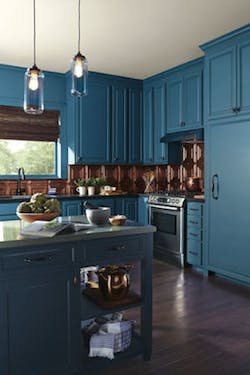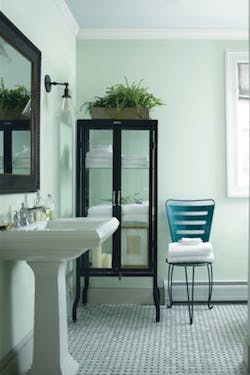Super-Powered Paints Take on Bacteria, Odors, and Mildew
The latest generation of interior paints focuses on indoor air quality. “We’re kind of entering a renaissance period for paints right now,” says Chris Connelly, director of brand management for Benjamin Moore. “The [paint industry] is doing one really good thing: It’s starting to put the end user at the center of its development instead of [introducing] technology for technology’s sake.”
Here are four examples from Sherwin-Williams and Benjamin Moore, two leading U.S. paint manufacturers.
How this New Paint Kills Bacteria
A new paint designed to kill bacteria in hospitals could find its way onto the interior walls of homes where germs are a concern.
In February, Sherwin-Williams launched Paint Shield (shown, below), the first paint registered with the Environmental Protection Agency for its ability to kill common bacteria on painted surfaces. The microbicidal paint reportedly kills greater than 99.99 percent of five harmful types of bacteria within two hours of exposure on a painted surface. The paint’s pathogen-fighting property lasts up to four years, according to Rick Watson, Sherwin-Williams’ director of product information.
The paint also kills methicillin-resistant Staphylococcus aureus, or MRSA. This antibiotic-resistant bacteria often causes skin infections and is very tough to treat. The pathogen can infect surgical wounds, the bloodstream, the lungs, and the urinary tract.
Although most MRSA infections are seen in medical settings, the bug has also caused problems in the general population. Known as community-associated MRSA, it generally begins as a painful boil and is spread by skin-to-skin contact. At-risk populations include athletes, child care workers, and people who live in crowded conditions.
Paint Shield is designed to kill three other bacteria as well. Escherichia coli (E. coli), which affects people who eat tainted food or drink tainted water and typically causes fever and diarrhea. VRE (vancomycin-resistant Enterococcus), which can infect the intestines, urinary tract, and open wounds. And Enterobacter aerogenes, which can cause serious infections of the skin, abdomen, eyes, and respiratory system.
Scientists from Sherwin-Williams collaborated with microbiologists to formulate Paint Shield. The paint contains bacteria-fighting microbicides, which are sometimes prescribed as medicine to prevent infections in high-risk patients. The effort was in response to requests from hospitals, schools, day care centers, hotels, cruise ships, and similar facilities for tools to prevent the spread of pathogens on surfaces, Watson says. Paint Shield comes in 550 colors and an eggshell finish. It can be applied to nonporous interior ceilings, walls, doors, and trim.
Glossy Sheen: Enhanced Mildew Fighter
Homeowners sometimes shy away from mildew-resistant bathroom paint because of its glossy sheen. “The industry was forcing people into a finish they didn’t want,” says Benjamin Moore’s Connelly. “Designers want to achieve the true depth of a paint’s color. That comes with a flat finish.”
Benjamin Moore’s Aura Bath & Spa (shown, right) “tries to take that shackle away from people,” Connelly says. The interior water-based paint, formulated to resist mildew growth in humid rooms, is made without surfactants—the ingredients that help stabilize the product. Surfactants sometimes leach from the paint and can create spots and drips on the surface of the wall in a humid room. Aura Bath & Spa is a paint and primer in one, cleans up with soap and water, comes in all of the manufacturer’s colors, and offers a matte finish.
Odor Eater
Not only does Sherwin-Williams’ zero-VOC Harmony interior latex paint contain no formaldehyde, it removes formaldehyde that other products, such as insulation, carpet, cabinets, and fabrics, have released into the home’s air, the company says. The GreenGuard-certified product is also designed to reduce pet, cooking, and cigarette odors.
A study by Sherwin-Williams and the UL-GreenGuard Institute demonstrates that the paint’s formaldehyde-reducing technology can decrease those airborne VOCs by up to 45 percent. And a separate odor-eliminating technology reduces pet and cooking odors. The paint also contains anti-microbial agents that inhibit odor from mold and mildew and combat their growth on the paint’s surface, the company says. Harmony paint doesn’t lose its abilities when color is added, Watson says, as long as the colorant is VOC-free. Harmony is available in flat, eggshell, and semi-gloss finishes.
Allergen-Resister
Benjamin Moore’s Natura paint has been certified by the Asthma and Allergy Foundation of America as “asthma and allergy friendly.”
“It’s the company’s most environmentally friendly paint,” says Connelly, noting that it contains no VOCs and produces zero emissions. Even the painter will not be exposed to harsh fumes, and the company calls the paint “virtually odorless.” Natura has zero measurable emissions at the time it’s applied and zero emissions three days later. And the company achieved this without sacrificing quality, Connelly notes. “Historically, when you made a choice that you want a greener, safer paint, you made a compromise in durability and washability. If we were having this conversation in 2000, we would be talking about a reduction [of those things].”
Since then, however, Benjamin Moore has developed resins using greener, safer raw materials, officials say. Natura comes in flat, eggshell, and semi-gloss finishes.


